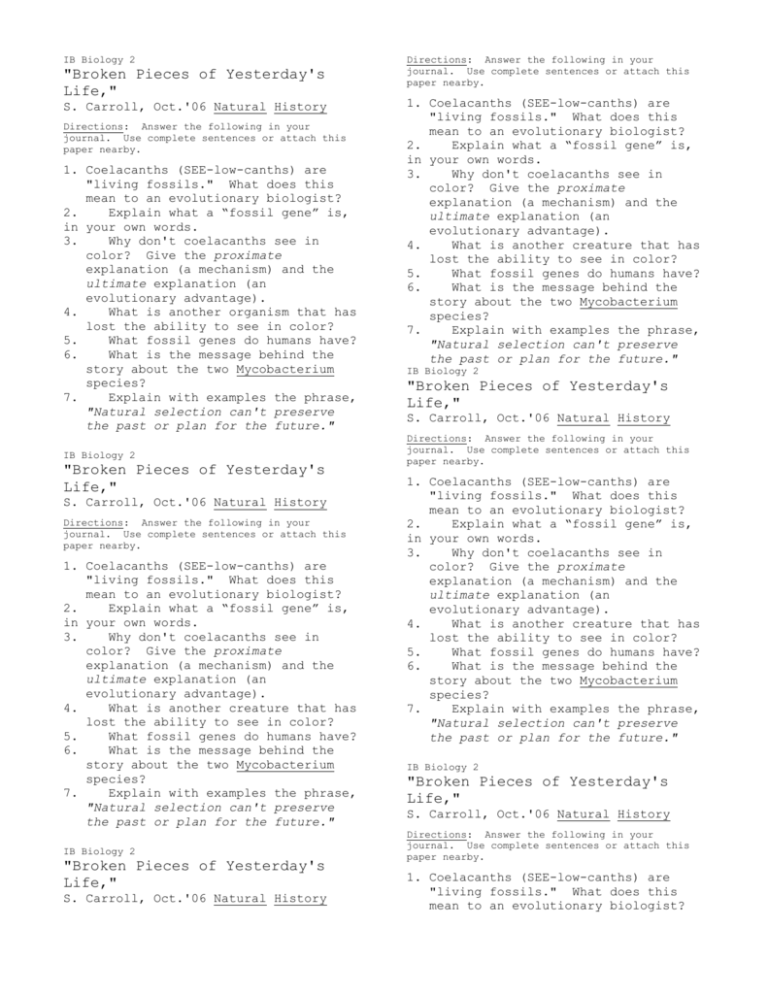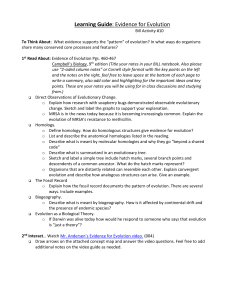Broken Pieces questions
advertisement

IB Biology 2 "Broken Pieces of Yesterday's Life," S. Carroll, Oct.'06 Natural History Directions: Answer the following in your journal. Use complete sentences or attach this paper nearby. 1. Coelacanths (SEE-low-canths) are "living fossils." What does this mean to an evolutionary biologist? 2. Explain what a “fossil gene” is, in your own words. 3. Why don't coelacanths see in color? Give the proximate explanation (a mechanism) and the ultimate explanation (an evolutionary advantage). 4. What is another organism that has lost the ability to see in color? 5. What fossil genes do humans have? 6. What is the message behind the story about the two Mycobacterium species? 7. Explain with examples the phrase, "Natural selection can't preserve the past or plan for the future." IB Biology 2 "Broken Pieces of Yesterday's Life," S. Carroll, Oct.'06 Natural History Directions: Answer the following in your journal. Use complete sentences or attach this paper nearby. 1. Coelacanths (SEE-low-canths) are "living fossils." What does this mean to an evolutionary biologist? 2. Explain what a “fossil gene” is, in your own words. 3. Why don't coelacanths see in color? Give the proximate explanation (a mechanism) and the ultimate explanation (an evolutionary advantage). 4. What is another creature that has lost the ability to see in color? 5. What fossil genes do humans have? 6. What is the message behind the story about the two Mycobacterium species? 7. Explain with examples the phrase, "Natural selection can't preserve the past or plan for the future." IB Biology 2 "Broken Pieces of Yesterday's Life," S. Carroll, Oct.'06 Natural History Directions: Answer the following in your journal. Use complete sentences or attach this paper nearby. 1. Coelacanths (SEE-low-canths) are "living fossils." What does this mean to an evolutionary biologist? 2. Explain what a “fossil gene” is, in your own words. 3. Why don't coelacanths see in color? Give the proximate explanation (a mechanism) and the ultimate explanation (an evolutionary advantage). 4. What is another creature that has lost the ability to see in color? 5. What fossil genes do humans have? 6. What is the message behind the story about the two Mycobacterium species? 7. Explain with examples the phrase, "Natural selection can't preserve the past or plan for the future." IB Biology 2 "Broken Pieces of Yesterday's Life," S. Carroll, Oct.'06 Natural History Directions: Answer the following in your journal. Use complete sentences or attach this paper nearby. 1. Coelacanths (SEE-low-canths) are "living fossils." What does this mean to an evolutionary biologist? 2. Explain what a “fossil gene” is, in your own words. 3. Why don't coelacanths see in color? Give the proximate explanation (a mechanism) and the ultimate explanation (an evolutionary advantage). 4. What is another creature that has lost the ability to see in color? 5. What fossil genes do humans have? 6. What is the message behind the story about the two Mycobacterium species? 7. Explain with examples the phrase, "Natural selection can't preserve the past or plan for the future." IB Biology 2 "Broken Pieces of Yesterday's Life," S. Carroll, Oct.'06 Natural History Directions: Answer the following in your journal. Use complete sentences or attach this paper nearby. 1. Coelacanths (SEE-low-canths) are "living fossils." What does this mean to an evolutionary biologist? 2. Explain what a “fossil gene” is, in your own words. 3. Why don't coelacanths see in color? Give the proximate explanation (a mechanism) and the ultimate explanation (an evolutionary advantage). 4. What is another creature that has lost the ability to see in color? 5. What fossil genes do humans have? 6. What is the message behind the story about the two Mycobacterium species? 7. Explain with examples the phrase, "Natural selection can't preserve the past or plan for the future." IB Biology 2 "Broken Pieces of Yesterday's Life," S. Carroll, Oct.'06 Natural History Directions: Answer the following in your journal. Use complete sentences or attach this paper nearby. 1. Coelacanths (SEE-low-canths) are "living fossils." What does this mean to an evolutionary biologist? 2. Explain what a “fossil gene” is, in your own words. 3. Why don't coelacanths see in color? Give the proximate explanation (a mechanism) and the ultimate explanation (an evolutionary advantage). 4. What is another creature that has lost the ability to see in color? 5. What fossil genes do humans have? 6. What is the message behind the story about the two Mycobacterium species? 7. Explain with examples the phrase, "Natural selection can't preserve the past or plan for the future."





